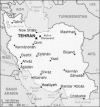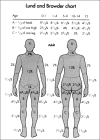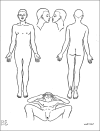The burn registry program in Iran - First report
- PMID: 26170796
- PMCID: PMC4441305
The burn registry program in Iran - First report
Abstract
Burn injury is still a major problem in Iran, resulting in many reports which are usually dispersed, uncoordinated and probably unreliable. We created a burn registry comprised of a data entry program with 222 variables for each admitted burn patient. This program was established in August 2010 at the Iran University of Medical Sciences, Motahari Burn Hospital. We had 14,277 burn patients from August 2010 to August 2011, 877 of whom were admitted to the hospital. Of the patients, 65.9% were male and 34.1% were female. The age was 28.85 years (SD = 19.77). The most prevalent cause of burn was flame 78.5% (pipe propane gas 57.2; kerosene 19.9%). The mean total body surface area (TBSA) involvement was 23%. A total of 77.8% of patients were discharged with partial recovery, while mortality was 8.9%. The mean hospital stay was 14.63 days (SD =11.07). The program is designed to help understand the scope of burn injury in Iran, providing information on patients, etiology, and course of treatment. It also highlights differences between various parts of the country in terms of the causes and frequency of burn injuries. Moreover, the burn registry provides a basis for further research and surveys for treatment and preventive programs. Our results showed that, although Emergency Medical Services (EMS) staff are highly capable and well-trained, their coverage seems to be less than 50% and needs to be increased. Marriage status was shown to have no influence on the occurrence of burns, and among our patients, 57.0 % were poorly educated.
Les blessures par brûlure sont toujours un problème majeur en Iran, résultant dans de nombreux rapports qui habituellement sont dispersés, mal coordonnés et probablement peu fiables. Nous avons créé un programme de saisie de données de registre de brûlure avec 222 variables pour chaque patient brûlé admis. Ce programme a été créé en Août 2010 à l'Université des sciences médicales de l'Iran, à l'hôpital Motahari. A partir d'Août 2010 jusqu'à Août 2011 nous avons eu 14,277 patients brûlés, dont 877 ont été hospitalisés. Parmi les patients, 65,9 % étaient des hommes et 34,1% étaient des femmes. L'âge moyen était de 28,85 années (SD = 19,77). La cause de brûlure la plus courante était la flamme (en 78,5% des cas, dont 57,2 % étaiaent causés par le gaz tuyau de propane et 19,9% par le kérosène). La moyenne de la surface corporelle totale (SCT) brulée était de 23%. 77,8 % des patients ont reçu leur congé avec récupération partielle, tandis que la mortalité était de 8,9%. La durée moyenne d'hospitalisation était de 14,63 jours (SD = 11:07). Ce programme a été conçu pour aider à comprendre la portée des brûlures en Iran, fournissant des informations sur les patients, l'étiologie et le traitement. En outre, il met en évidence les différences entre les diverses régions du pays en termes de la fréquence et les causes des brûlures. En plus, le registre fournit une base pour des recherches et des enquêtes sur le traitement et la prévention des brûlures. Nos résultats ont montré que, bien que le personnel EMS sont très capables et bien formés, la couverture des EMS semble être inférieure à 50% et doit être augmentée. Selon les résultats, le statut de mariage n'a aucune influence sur la survenue de brûlures. Enfin, parmi nos patients, 57,0% étaient peu instruits.
Keywords: burn; epidemiology; mortality; registry; risk factors.
Figures










Similar articles
-
The epidemiology of geriatric burns in Iran: A national burn registry-based study.Burns. 2016 Aug;42(5):1128-1132. doi: 10.1016/j.burns.2016.03.011. Epub 2016 Apr 25. Burns. 2016. PMID: 27126815
-
Epidemiology of severe burn injuries in a Tertiary Burn Centre in Tehran, Iran.Ann Burns Fire Disasters. 2011 Jun 30;24(2):59-62. Ann Burns Fire Disasters. 2011. PMID: 22262960 Free PMC article.
-
Economical Burden of Burn Injuries in a Developing Country.J Burn Care Res. 2017 Nov/Dec;38(6):e900-e905. doi: 10.1097/BCR.0000000000000515. J Burn Care Res. 2017. PMID: 28296667
-
Severe burns in Australian and New Zealand adults: Epidemiology and burn centre care.Burns. 2019 Sep;45(6):1456-1461. doi: 10.1016/j.burns.2019.04.006. Epub 2019 Apr 30. Burns. 2019. PMID: 31053412
-
Epidemiology of burns in Iran during the last decade (2000-2010): review of literature and methodological considerations.Burns. 2012 May;38(3):319-29. doi: 10.1016/j.burns.2011.09.025. Epub 2011 Nov 25. Burns. 2012. PMID: 22119445 Review.
Cited by
-
Epidemiology and the survival rate of burn-related injuries in Iran: a registry-based study.Ann Burns Fire Disasters. 2019 Mar 31;32(1):3-9. Ann Burns Fire Disasters. 2019. PMID: 31285727 Free PMC article.
-
Effect of sticky mat usage in control of nosocomial infection in Motahary Burn Hospital.Iran J Microbiol. 2016 Jun;8(3):210-213. Iran J Microbiol. 2016. PMID: 27928489 Free PMC article.
-
Financial burden of burn injuries in iran: a report from the burn registry program.Ann Burns Fire Disasters. 2015 Dec 31;28(4):310-314. Ann Burns Fire Disasters. 2015. PMID: 27777552 Free PMC article.
-
The epidemiology of burns in Basra, Iraq.Ann Burns Fire Disasters. 2017 Sep 30;30(3):167-171. Ann Burns Fire Disasters. 2017. PMID: 29849517 Free PMC article.
-
Determinants of the Lethal Area 50 Index (LA50) in Burn Patients Admitted to a Tertiary Referral Burn Center in Southern Iran.Bull Emerg Trauma. 2018 Jan;6(1):59-63. doi: 10.29252/beat-060109. Bull Emerg Trauma. 2018. PMID: 29379811 Free PMC article.
References
-
- WHO. fact sheet No. 365. 2012 May;
-
- Mirmohammadi SJ, Mehrparvar AH, Jalilmanesh M, Kazemeini K, Delbari N, Mostaghaci M. An epidemiologic survey on burns in Yazd from 2008 till 2009. Acta Med Iran. 2012;50:70–5. - PubMed
-
- Sadeghi-Bazargani H, Mohammadi R. Epidemiology of burns in Iran during the last decade (2000-2010): Review of literature and methodological considerations. Burns. 2012;38:319–29. - PubMed
LinkOut - more resources
Full Text Sources
